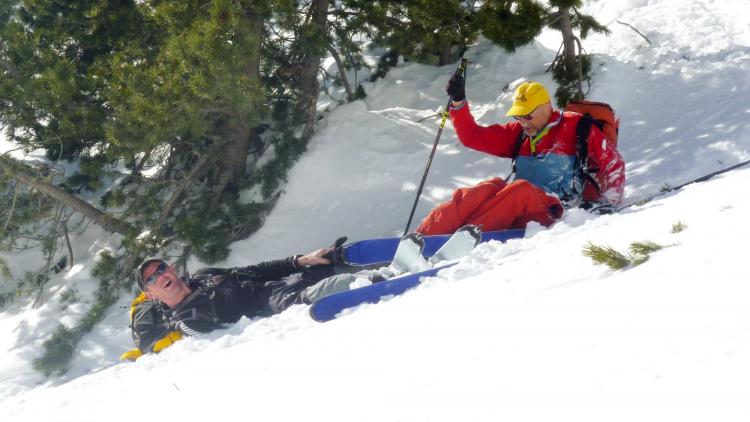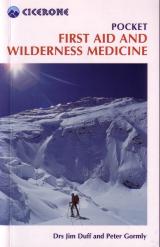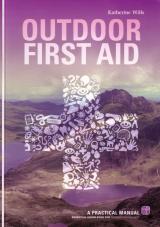 Accidents can happen at any time to any member of a ski touring party and all members of the party must be able to provide First Aid to someone who has been injured. This isn’t just the leader’s responsibility - it may be the leader who has been hurt!. In the Alps, help can often be summoned quite quickly by mobile phone and delivered by helicopter; however this isn’t always the case – there may be no phone signal, or the weather may prevent helicopters from flying. A party must be prepared to be self-reliant. In remote locations this is obviously even more important.
Accidents can happen at any time to any member of a ski touring party and all members of the party must be able to provide First Aid to someone who has been injured. This isn’t just the leader’s responsibility - it may be the leader who has been hurt!. In the Alps, help can often be summoned quite quickly by mobile phone and delivered by helicopter; however this isn’t always the case – there may be no phone signal, or the weather may prevent helicopters from flying. A party must be prepared to be self-reliant. In remote locations this is obviously even more important.
Courses
Standard First Aid courses often assume that professional help can quickly reach the scene. This often isn’t the case whilst ski touring so a REC (Rescue Emergency Care) course geared to a mountain environment will be more appropriate.
The Eagle Ski Club normally runs a REC course every year or so (generally in the Autumn) – details are published in the Programme of UK Events. Similar courses are also provided by the Austrian Alpine Club and the BMC.
In order to keep the knowledge fresh, it is recommended that such a course is repeated every three years.
First Aid books relevant to ski touring
Pocket First Aid and Wilderness Medicine by Drs Jim Duff and Ross Anderson
(published by Cicerone – Twelfth Edition, 2017 – third edition by Cicerone)
Outdoor First Aid by Katherine Wills (who runs REC courses for the club)
(published by Pesda Press – 2013)
Ski Touring First Aid Kits
The content of an ideal ski touring first aid kit was brainstormed at ESC leaders meet in 2022. The discussion is summarised in the article First aid kits – What to take and why.
The resulting suggested contents list for a Ski Touring Group First aid Kit (suitable for a non-medical first aider, for a hut-to-hut ski tour of 6 members for 1 week) is available for print out and reference, along with a Casualty Report form for documentation and handover.
A webinar on our YouTube channel, by Dr Declan Phelan, looks at what we should carry in our first aid kit and how to manage cold injuries, such as frostnip and frostbite. The webinar was based on interactive, case-based discussion. You can find it here:
Cold Injuries and First Aid Kits
Avalanche First Aid
Companion rescue and first aid/resuscitation are an avalanche victim’s best chance of survival, so it is important that all ski tourers know how to deliver effective avalanche first aid.
In 2014, ESC members Dr Catherine Mangham (Diploma in Mountain Medicine) and Terry Ralphs (IFMGA) developed the ESC Avalanche First Aid card, giving the non-medical rescuer an easy-to-follow algorithm for companion rescue and avalanche first aid. This has been updated 2023, as has an accompanying summary article explaining the principles behind ESC Avalanche First Aid.
The 2025 version can be downloaded for printing here ESC Avalanche First Aid Card 2025.
High Altitude Sickness
A summary of the physiology, prevention, recognition and treatment of High Altitude Sickness is given in an article by Catherine Mangham in an article in the Eagle Ski Club Yearbook 2013.
Hypothermia and Frostbite
An article by Dr Declan Phelan in the Eagle Ski Club Yearbook 2013 provides an overview of the causes, diagnosis and treatment of hypothermia and of frostbite.
A webinar by Dr Declan Phelan on managing hypothermia when ski touring, covering the current science and then working through a scenario on a Haute Route ski tour, is also available on our YouTube channel:
Friction Blisters
Friction Blisters are by far the commonest medical problem in ski touring parties and unfortunately continue to limit or force abandonment of individual ski tours every season.
Prevention is undoubtedly the key and important strategies include:
- Well-fitting ski boots – worth spending time and money with an experienced ski touring boot fitter
- “Breaking in” you new ski boots – although modern ski boots can be worn straight from the box it is still important to get your feet used to them, by wearing at home and ideally on a few day tours before you commit to a hut to hut or remote tour.
- Direct blister preventative strategies include:
- Petroleum jelly: to reduce friction.
- Double socks: thin sock liner with low friction against the skin and a thicker wool sock with higher friction against the insole.
- Preventative taping: must have a very high coefficient of friction to stay in position.
All have their proponents and detractors, but it is best to find what works for you and to stick with it.
- Early intervention – Stop if you feel a “hot spot” developing and address the issue (e.g. adjusting buckles; adjusting socks; prophylactic taping or blister dressing) – far better to have a few minutes faff than to limit your tour.
Here is a link to an excellent article on Friction Blisters: Prevention and Treatment by Dr Suzy Stokes.
| Attachment | Size |
|---|---|
| ESC Avalanche First Aid Card 202526.62 KB | 26.62 KB |
| ESC Avalanche First Aid article 2023935.78 KB | 935.78 KB |
| ESC Group First Aid Kit.2022113.18 KB | 113.18 KB |
| Casualty Report Form182.46 KB | 182.46 KB |


